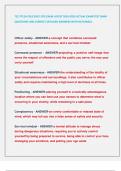TCC PTLEA FDLE SOCE CPO EXAM LATEST 2024-2025 ACTUAL EXAM TEST BANK
QUESTIONS AND CORRECT DETAILED ANSWERS WITH RATIONALE .
Officer safety - ANSWER-a concept that combines command
presence, situational awareness, and a survival mindset
Command presence - ANSWER-projecting a positive self-image that
earns the respect of offenders and the public you serve; the way your
carry yourself
Situational awareness - ANSWER-the understanding of the totality of
your cirucmstances and surroundings, it also contributes to officer
safety and requires maintaining a high level of alertness at all times
Positioning - ANSWER-placing yourself in a tactically advantageous
location where you can best use your senses to determine what is
occurring in your vicinity, while remaining in a safe place
Complacency - ANSWER-an overly comfortable or relaxed state of
mind, which may lull you into a false sense of safety and security
Survival mindset - ANSWER-a mental attitude to manage stress
during dangerous situations, requiring you to actively control
yourself by being prepared to survive, being able to control your fees,
managing your emotions, and putting your ego aside
,Cover - ANSWER-such as automobile engine blocks, brick walls, dirt
embankments, concrete, steel, and thick wood which can protect you
from incoming gunfire
Concealment - ANSWER-can provide camouflage but will not stop
incoming gunfire
Community-policing - ANSWER-promotes organizational strategies
that support the systemic use of partnerships and problem-solving
techniques to proactively address public safety issues such as crime,
social disorder, and fear of crime
Organizational Transformation - ANSWER-the orientation of command
staff at all levels to support community partnerships and practice
problem-solving
Community-policing problem solving - ANSWER-the proactive
examination of community problems to develop and evaluate effective
criminal justice responses
Community-policing partnerships - ANSWER-increase understanding
and trust between you and community members which may include
law enforcement, government, and community representatives
,Interagency agreement - ANSWER-a formalized agreement template
that contains the principles of the community-policing partnership
Local criminal justice partnerships can include: - ANSWER-police
departments, sheriff's offices, code enforcement, animal control
State criminal justice partnerships can include: - ANSWER-FDLE,
FHP,
DCF,
FWC
Federal criminal justice partnerships can include: - ANSWER-ICE,
Department of Treasury & Secret Service,
United States Marshals Service,
FBI
Planned compliance initiative - ANSWER-a planned community
corrections initiative that often involve other criminal justice agencies
and targets specific groups of offenders to determine if they are
complying with their terms of supervision
Community control planned compliance initiative – ANSWER-
conducted at atypical hours to ensure offender compliance with
house arrest and other special conditions imposed by statute or
supervision order
Sec offender planned compliance initiative - ANSWER-conducted for
residence verification and include walk-through visual inspections
, and searches of living quarters to ensure compliance with conditions
of supervision and to ensure that offenders are not in possession of
pornography, children, or items that attract children
Ride-alongs - ANSWER-refers to a probation officer riding in a patrol
car in the field with a law enforcement officer
Physical signs of substance abuse can include: - ANSWER-bloodshot
eyes, sudden weight loss/gain, deterioration of physical appearance,
poor grooming habits, tremors, slurred speech, or impaired
coordination
Behavioral signs of substance abuse can include: - ANSWER-poor
work and school performance, financial problems, sudden
change in friends, family, and hobbies, frequently engaging in
fights and illegal activities
Psychological signs of substance abuse can include: - ANSWER-
unexplained change in personality and attitude, sudden mood
swings and irritability, lack of motivation, appearing lethargic
fearful, anxious, paranoid
Examples of depressants include: - ANSWER-Xanax, valium, GHB
Examples of stimulants include: - ANSWER-amphetamines, cocaine,
crystal meth




